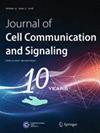二甲双胍联合雷帕霉素通过AMPK/mTOR信号通路改善特发性膜性肾病足细胞损伤。
IF 3.9
3区 生物学
Q3 CELL BIOLOGY
引用次数: 0
摘要
自噬激活保护特发性膜性肾病(IMN)足细胞损伤。AMPK/mTOR信号通路是一个重要的自噬调控通路。二甲双胍促进自噬,而雷帕霉素是自噬激动剂。然而,二甲双胍和雷帕霉素治疗IMN的机制尚不清楚。因此,我们研究了二甲双胍和雷帕霉素通过调节AMPK/mTOR自噬信号通路在IMN中的作用机制。雌性SD大鼠经阳离子牛血清白蛋白(C-BSA)处理建立IMN模型,随机分为IMN模型组、二甲双胍组、雷帕霉素组和二甲双胍+雷帕霉素组。另设对照组。二甲双胍和雷帕霉素治疗。检测肾脏组织学改变、尿蛋白排泄、关键AMPK/mTOR信号通路蛋白表达水平、肾组织细胞凋亡及自噬相关蛋白Beclin 1和LC3。此外,利用MPC-5小鼠足细胞细胞系建立C5b-9亚溶模型,验证二甲双胍联合雷帕霉素对足细胞的影响。二甲双胍联合雷帕霉素可改善IMN大鼠尿蛋白排泄。二甲双胍联合雷帕霉素可减轻炎症反应、肾纤维化和足细胞足突融合。此外,通过增强足细胞中Beclin-1、p-AMPK/AMPK、LC3-II/I和自噬体的表达,以及降低p-mTOR/mTOR的表达,可以改善足细胞的自噬。综上所述,二甲双胍联合雷帕霉素可通过AMPK/mTOR途径减少IMN大鼠的蛋白尿,改善肾纤维化和足细胞自噬。二甲双胍和雷帕霉素可减少IMN模型大鼠蛋白尿,改善肾纤维化。本文章由计算机程序翻译,如有差异,请以英文原文为准。
Metformin combined with rapamycin ameliorates podocyte injury in idiopathic membranous nephropathy through the AMPK/mTOR signaling pathway.
Autophagy activation protects against podocyte injury in idiopathic membranous nephropathy (IMN). The AMPK/mTOR signaling pathway is a vital autophagy regulatory pathway. Metformin promotes autophagy, whereas rapamycin is an autophagy agonist. However, the therapeutic mechanisms of metformin and rapamycin in IMN remain unclear. Thus, we examined the mechanisms of action of metformin and rapamycin in IMN by regulating the AMPK/mTOR autophagy signaling pathway. Female Sprague-Dawley (SD) rats were treated with cationic bovine serum albumin (C-BSA) to establish an IMN model and were randomly divided into IMN model, metformin, rapamycin, and metformin + rapamycin groups. A control group was also established. Metformin and rapamycin were used as treatments. Renal histological changes, urinary protein excretion, the protein expression levels of key AMPK/mTOR signaling pathway proteins, renal tissue cell apoptosis, and autophagy-associated proteins (Beclin 1 and LC3) were examined. In addition, a C5b-9 sublysis model using the MPC-5 mouse podocyte cell line was established to verify the effect of metformin combined with rapamycin on podocytes. Metformin combined with rapamycin improved urinary protein excretion in IMN rats. Metformin combined with rapamycin attenuated the inflammatory response, renal fibrosis, and podocyte foot process fusion. In addition, it improved autophagy in podocytes as demonstrated by the enhanced expression of Beclin-1, p-AMPK/AMPK, LC3-II/I, and autophagosomes in podocytes and decreased p-mTOR/mTOR expression. In conclusion, metformin combined with rapamycin decreased proteinuria, improved renal fibrosis and podocyte autophagy via AMPK/mTOR pathway in IMN rats. The metformin and rapamycin decreased proteinuria and inproved renal fibrosis in IMN model rats.
求助全文
通过发布文献求助,成功后即可免费获取论文全文。
去求助
来源期刊

Journal of Cell Communication and Signaling
CELL BIOLOGY-
CiteScore
6.40
自引率
4.90%
发文量
40
期刊介绍:
The Journal of Cell Communication and Signaling provides a forum for fundamental and translational research. In particular, it publishes papers discussing intercellular and intracellular signaling pathways that are particularly important to understand how cells interact with each other and with the surrounding environment, and how cellular behavior contributes to pathological states. JCCS encourages the submission of research manuscripts, timely reviews and short commentaries discussing recent publications, key developments and controversies.
Research manuscripts can be published under two different sections :
In the Pathology and Translational Research Section (Section Editor Andrew Leask) , manuscripts report original research dealing with celllular aspects of normal and pathological signaling and communication, with a particular interest in translational research.
In the Molecular Signaling Section (Section Editor Satoshi Kubota) manuscripts report original signaling research performed at molecular levels with a particular interest in the functions of intracellular and membrane components involved in cell signaling.
 求助内容:
求助内容: 应助结果提醒方式:
应助结果提醒方式:


